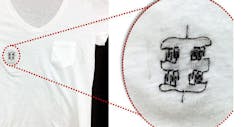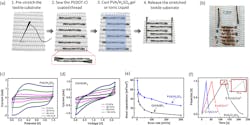>> Website Resources
.. >> Library: TechXchange
.. .. >> TechXchange: Power Management
.. .. .. >> Topic: Energy Harvesting
Using textiles and fabrics for harvesting power, storing energy, and bio-sensing makes sense—after all, everyone wears a shirt. A team at the University of Massachusetts has developed a way to combine vapor-coated conductive threads with a polymer film, via a special sewing technique, to create a flexible mesh of aligned electrodes on a textile backing. The result is what they call a distributed micro-supercapacitor (MSC) that can store charge and thus power biosensors and related devices.
The team, led by Chemistry Professor Trisha L. Andrew (director of the UMass Wearable Electronics Lab), devised a process that creates porous, conducting polymer films on densely twisted yarns. These can then be swelled with electrolyte ions to maintain a charge-storage capacity per unit length, which is much higher than prior efforts achieved with dyed or extruded fibers. In this technique, conductive threads are vapor-coated with a p-doped conducting polymer film, which then can be sewn onto as a path onto stretchy textile.
Each electrode is made of two stainless-steel threads coated with p-doped poly(3,4-ethylenedioxythiophene) material (PEDOT-Cl) and stacked to form a 3D architecture with 5 mm length, 0.6 mm width, and 1.2 mm height. Then a gel electrolyte is deposited over the electrodes to insulate them and prevent inter-electrode contact (Fig. 1). Before the electrolyte fully solidifies, the pre-stretched substrate is released and the gel wrinkles; this prevents folding-induced microcracks and yields a compact, pliable device.
2. Pictures of the textile MSC subjected to various mechanical distortions (a); galvanostatic charge/discharge curves measured as the device was bent, twisted, or rolled up—the charge/discharge curves of the deformed device resemble that of a flat device (b); cycle stability of the textile MSC measured at a fast scan rate of 7 mA/cm2 (c); areal “Ragone” plot comparing the textile MSC reported here to other state-of-the-art flexible MSC (d). All are detailed in the paper’s references. (Source: UMass Wearable Electronics Lab)
Tolerance to extreme mechanical distortions is obviously important for wearable charge storage technologies, which are subjected to constant movements and deformations. These textile MSCs are also super-deformable with relatively unchanged electrochemical performance even after fully rolling-up the device.
The researchers report that the capacitance of the device is surprisingly and reproducibly recoverable: After the first 4000 cycles, 71% of the initial capacitance is retained, and it recovered to 93% after a 12-hour no-operation period. After another 4000 cycles, the capacitance again shows a 71% capacitance retention, which recovers to 93% after another 12-hour rest period. They speculate that one possible reason for this behavior is the redistribution of unbalanced charges in the solid-state device during the rest period.
The team noted that “incorporating electrochemically active materials with high electrical conductivities and rapid ion transport into textiles is challenging. With this paper, we show that we can literally embroider a charge-storing pattern onto any garment using the vapor-coated threads that our lab makes. This opens the door for simply sewing circuits on self-powered smart garments.”
Their detailed research paper “High Energy Density, Super-Deformable, Garment-Integrated Microsupercapacitors for Powering Wearable Electronics” was published in the Applied Materials Interfaces journal of the American Chemical Society, and the project was supported by the David and Lucille Packard Foundation.
About the Author

Bill Schweber
Contributing Editor
Bill Schweber is an electronics engineer who has written three textbooks on electronic communications systems, as well as hundreds of technical articles, opinion columns, and product features. In past roles, he worked as a technical website manager for multiple topic-specific sites for EE Times, as well as both the Executive Editor and Analog Editor at EDN.
At Analog Devices Inc., Bill was in marketing communications (public relations). As a result, he has been on both sides of the technical PR function, presenting company products, stories, and messages to the media and also as the recipient of these.
Prior to the MarCom role at Analog, Bill was associate editor of their respected technical journal and worked in their product marketing and applications engineering groups. Before those roles, he was at Instron Corp., doing hands-on analog- and power-circuit design and systems integration for materials-testing machine controls.
Bill has an MSEE (Univ. of Mass) and BSEE (Columbia Univ.), is a Registered Professional Engineer, and holds an Advanced Class amateur radio license. He has also planned, written, and presented online courses on a variety of engineering topics, including MOSFET basics, ADC selection, and driving LEDs.



